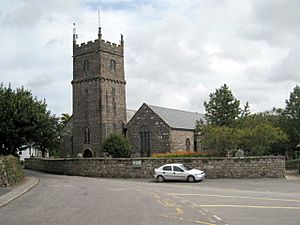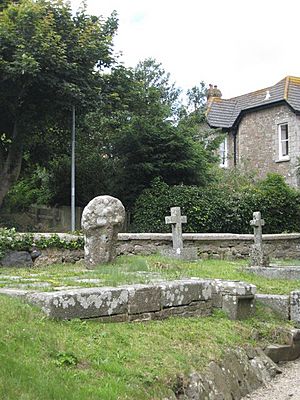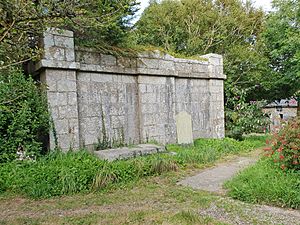St Maddern's Church, Madron facts for kids
Quick facts for kids St Maddern's Church, Madron |
|
|---|---|
 |
|
| 50°7′53.81″N 5°33′53.59″W / 50.1316139°N 5.5648861°W | |
| Location | Madron |
| Country | England |
| Denomination | Church of England |
| Churchmanship | Broad Church |
| History | |
| Dedication | St Maddern |
| Consecrated | 1336 |
| Specifications | |
| Bells | 8 (1761–1950) |
| Administration | |
| Parish | Madron |
| Deanery | Penwith |
| Archdeaconry | Cornwall |
| Diocese | Truro |
| Province | Canterbury |
St Maddern's Church is an old and important church located in Madron, a village near Penzance in Cornwall, England. It used to be the main church for nearby areas like Morvah and Penzance. This church is so special that it's officially recognized as a Grade I listed building, which means it's a very important historic site.
Contents
Exploring St Maddern's Church Design
The church building is quite large and was mostly built in the 15th century (the 1400s). However, some parts, like the chancel (the area around the altar), are even older, dating back to the 14th century (the 1300s). You can also find a very old stone bowl called a font, which was used for baptisms. It's thought to be from the Norman period, which was a very long time ago! There are also a few old wooden bench ends that show how people used to sit in the church.
A Look Back at the Church's Past
How the Church Began
The story of St Maddern's Church goes back a long way. In the 12th century (the 1100s), the church and a nearby estate called Landithy were given to the Knights Hospitallers. These were a group of knights who helped pilgrims and the sick. A vicarage, which is the home for the church's priest, was set up in 1278.
The church was officially dedicated in 1336 by the Bishop of Exeter. This was a big event! The Bishop traveled from Exeter with many important people, including two archdeacons and the head of the Knights of St. John from London. They also had many other clergymen, knights, and servants with them. This dedication was part of a larger trip where the Bishop consecrated 14 other churches that summer.
Finishing the Church Building
The church building wasn't fully finished until around 1500. At that time, the vicar (the priest) was Benedict Tregos. He had supported Perkin Warbeck, who claimed to be a prince and tried to become king in 1497. Warbeck was defeated, but Tregos managed to avoid trouble with King Henry VII. He did this by paying to build the north aisle (a side section of the church) himself. He also decorated the church with Tudor roses, which were a symbol of the king, and put the king's coat of arms on expensive wooden panels. His plan worked, and he lived many more peaceful years. Inside the church, you can find a special brass plaque for John Clies and his family from 1623.
Making the Church New Again
In 1837, records show the cost of repairing pews. Back then, important people in the village had their own special pews, while others likely stood at the back. By 1855, people decided the church needed a big makeover. They wanted to make it "worthy of the sacred purpose for which it was built."
So, all the old pews were removed, and new, matching pews were put in. They also added heating and lighting, and the floor in the chancel was replaced. By 1889, the church looked much like it does today, thanks to these big changes.
The Church Bells
The bells that ring out over Madron have a long and interesting history. The first set of three bells was put in the church tower in the early 1700s. But in 1761, the village decided to sell these bells and buy a new set of five. These new bells were ordered from a company in Bridgwater.
However, one of the bells, the third one, caused a lot of problems. It had to be sent back to be re-made several times! It was re-cast in Helston and then again in Loughborough. Two other bells also weren't quite right and were re-cast in Hayle in 1823.
This situation continued until 1898, when the bells needed more work. This happened to be around the time of Queen Victoria’s Diamond Jubilee, so a sixth bell was added. Later, in 1950, two more bells were added, making a total of eight. The complete set of eight bells was officially dedicated on March 3, 1951.
Here's a look at the bells that ring today:
| weight | inscription | founded | |
|---|---|---|---|
| (cwts, qtrs, lbs) | |||
| 1 | 3-2-19 = 411 pounds (186 kg) | “In memory of John Kemp White, 1867–1947, Choirmaster and organist. His children’s gift” | 1950 |
| 2 | 4-0-0 = 448 pounds (203 kg) | “The gift of the Truro Diocesan Guild of Ringers. In memory of John Symons MRCS.” | 1950 |
| 3 | 4-0-5 = 453 pounds (205 kg) | “God save our Queen and church. William Borlase Tremenheere, vicar.” | 1898 |
| 4 | 4-2-23 = 527 pounds (239 kg) | “Number 3” | 1761 |
| 5 | 4-2-27 = 531 pounds (241 kg) | "Rev. Michael Nowell Peters (vicar), P. Kempe (churchwarden)." | Recast Loughborough 1842 |
| 6 | 4-3-3 = 535 pounds (243 kg) | “Rev. W. Tremenheere (vicar), Jas. Glasson (churchwarden).” | Re-cast Hayle 1823 |
| 7 | 6-3-15 = 771 pounds (350 kg) | “Number 2.” | Re-cast Hayle 1823 |
| 8 | 9-2-8 = 1,072 pounds (486 kg) | “Walter Borlase (vicar), Thos. Jenkin (churchwarden).” | 1761 |
The Church Organ
St Maddern's Church also has a pipe organ built by a company called Hele and Co. An organ is a large musical instrument that uses pipes to make sound. You can find more detailed information about this specific organ on the National Pipe Organ Register.
The Churchyard and Burials
By 1820, the churchyard, which is the burial ground around the church, was full. So, it was decided that it needed to be made bigger. This was a big project! It involved extending the churchyard to the north, which meant tearing down a small house and paying its owner. They also had to move a stream that came from Madron Well and raise the ground level by six feet to match the rest of the churchyard.
This work was finally finished in 1828, and the new burial ground was blessed by the Bishop of Exeter. The whole project cost quite a lot of money back then: £369 11s 6d. Interestingly, the churchyard was full again by 1878! So, the church side of Madron cemetery was blessed the next year by Edward White Benson, who was the Bishop of the new diocese of Truro. A famous architect named Edmund Sedding is buried here.
The Rose-Price Mausoleum
To the north-east of the church, there's a special building called a mausoleum. It's made of granite and is also a Grade II listed building, meaning it's historically important. This mausoleum belongs to the Rose-Price family from Trengwainton.
The mausoleum was opened in 1881 for the first time in almost 50 years for the burial of Mrs. Louisa Douglas Nugent. A newspaper report from The Cornishman described how the "gloomy-looking huge mausoleum" was opened "block by block." Inside, there are stone slabs with space for eighteen coffins below a brick-lined dome, and another vault for six more. A granite block inside says, "Sir Rose Price, Bart., erected this tomb Anno 1827." Several members of the Rose-Price family are buried there, including Sir Rose Price himself, his wife, and his eldest son.



